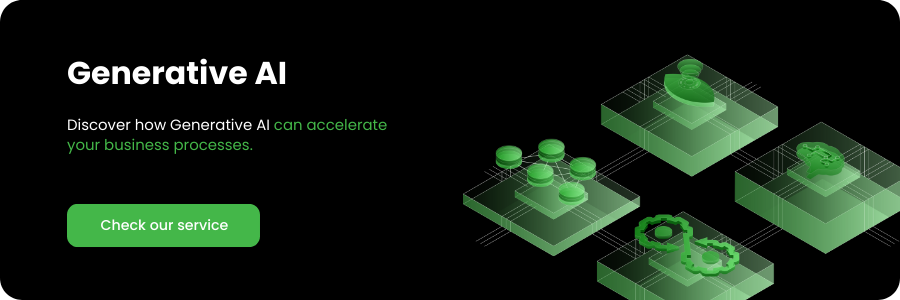
March 29, 2024
How to Program AI Chatbots: Complete Development Guide with Features & Languages (2025)
Author:

CSO & Co-Founder
Reading time:
12 minutes
As customer demand for exceptional customer service intensifies, businesses are figuring out new ways to keep customers engaged without increasing overhead costs. In order to achieve this, businesses need an interactive system that can provide real-time support and respond to inquiries with a human-like dialogue – that’s where AI chatbots come in.
Artificial Intelligence (AI) chatbots have a proven track record of providing 24/7 customer support without requiring specialized staff. Elkjøp, a consumer electronics retailer, recently put this notion into practice and reported an 80% customer satisfaction rate[1]. Unless you’re an experienced computer scientist, programming an AI chatbot from scratch might seem complicated and unattainable. Fortunately, it’s actually a pretty straightforward process.
This article will provide a detailed guide to AI chatbot programming from scratch, including the most popular types of chatbots and the features needed to optimize them for optimum effectiveness.
Unlock the potential of document analysis with Addepto’s cutting-edge AI Text Analysis Tool!
Types of Chatbots
There are several types of chatbots, each suited to a specific purpose. But, before we get to the types, it is important to first define what a chatbot is in the first place.
A chatbot is basically a program designed to simulate human-like conversations with users in a chat. The primary purpose of a chatbot is to provide answers to queries and handle multiple users simultaneously. [2]
Here are the six most popular types of chatbots adopted by businesses across various sectors:

Linguistic-based chatbots
Also known as rule-based chatbots, linguistic-based chatbots work in conversational automation flows using an if/then logic. Basically, these chatbots are only effective in cases where you can predict the type of questions your customers may ask.
To create a linguistic-based chatbot, you first have to define its language conditions. This includes the language parameters it has access to, the order in which the words appear, any synonyms in the selected words, and more.
This way, when a customer makes a query, the chatbot matches it to the set conditions and provides an appropriate response.
But for the chatbot to be effective, you have to ensure that each permutation of words matches the corresponding questions. Failure to do this will limit the chatbot’s ability to understand and respond to user queries. The rigidity and specificity demands of linguistic chatbots make them incredibly slow to develop. But once you define all parameters, these chatbots are pretty effective for small businesses dealing with a limited number of products or services.
Menu/Button-based chatbots
Menu-based chatbots are the most basic types of chatbots implemented in the market today. These chatbots work on a decision tree logic whereby users seek answers to their queries by following a set of buttons.
This makes menu-based chatbots especially popular among businesses that need an efficient means of answering FAQs.
Unfortunately, menu-based chatbots fall short when it comes to complex applications with too many variables. They are also the slowest chatbots available.
Keyword recognition-based chatbots
Keyword recognition-based chatbots use a combination of customizable keywords and Natural Language Processing AI applications to determine the appropriate answer to user queries. This mode of operation gives them the capabilities of both linguistic and menu-based chatbots since users can ask questions directly or use the chatbot’s buttons to get their desired answers.
On the flip side, keyword recognition-based chatbots aren’t very effective when it comes to answering a lot of similar questions. The NLP AI applications sometimes slip due to keyword redundancies in multiple related questions.
![]()
It might be interesting for you: Not only GPT. What are the best NLP GPT alternatives worth looking into?
![]()
Machine learning chatbots
Machine learning chatbots work on a contextual basis. They utilize AI and machine learning (ML) applications to remember previous conversations and improve over time. This gives them contextual awareness since they are able to self-improve based on the nature of user input, i.e., what users ask and how they ask it.

With time, the chatbot also learns about each user’s preferences and uses the data to streamline the next session with individual users. This mode of operation enables machine-learning chatbots to provide personalized answers quickly and effectively.
Hybrid model chatbots
Hybrid chatbots combine the simplicity of rule-based chatbots with the complexity of machine-learning chatbots. Essentially, these chatbots work by combining multiple tools such as rule-based systems, machine learning models, and decision trees.
Ultimately, this mode of operation enables hybrid model chatbots to handle a wider range of inputs, provide more accurate and relevant responses, and improve over time with more data.
Voice bots
Voice bots are the newest addition to the chatbot umbrella. Voice bots are essentially conversational agents that interact with users through voice interactions. They achieve this by leveraging speech recognition and natural language processing (NLP) technologies. [3]
Voice bots are designed to understand and respond to voice commands, which include answering questions and performing tasks such as playing music, setting reminders, and controlling smart home devices. Some of the most notable examples of voice bots are virtual assistants like Amazon’s Alexa and Apple’s Siri.

Chatbot features
The primary purpose of any chatbot is to enable businesses to communicate effectively with their customers. Therefore, as you build your chatbot, you must consider the following features in your design to facilitate seamless conversational experiences.

Omnichannel messaging support
Businesses that leverage omnichannel communication strategies with their customers enjoy 91% greater customer retention than those that use single-channel strategies. [4] Incorporating an omnichannel support feature in your chatbot can enable you to integrate it into multiple communication channels like websites, Whatsapp, and Facebook, thus streamlining customer interactions.
Leveraging omnichannel messaging support can also help you better understand your customers and use data from previous communications across multiple channels to drive future conversations with customers. The result is better personalization and improved customer experience, which drives conversion and customer retention.
Live chat handover
No matter how sophisticated your chatbot is, there are certain instances where human intervention is required to satisfy user requests. In such cases, you need a well-integrated fallback feature to facilitate the handover to a human agent.
Live chat handovers are typically required when the bot cannot respond to complex customer queries or when the customer specifically requests to talk to a human agent.
Sentiment analysis
Sentiment analysis is a chatbot feature that enables it to understand the emotion behind a user’s query. Sentiment analysis typically involves deriving sentiments, opinions, or thoughts from user input in order to understand and respond accordingly. [5]
Chatbots with this feature can understand the user’s mood through verbal cues and sentence structure and then adjust their response accordingly to improve customer satisfaction.
Chatbot marketing
An effective chatbot shouldn’t just communicate and answer questions. It should also enable you to automate your marketing strategy and push customers through the sales funnel. The marketing feature can enable you to perform numerous marketing activities like taking orders, tracking them, scheduling meetings, and sharing updates.
Chatbots with the marketing feature can also segment customers based on previous interactions, thus enabling you to improve your marketing strategy and gain insights into customer needs and preferences as they move through the sales funnel.
![]()
Read more about AI in digital marketing
![]()
Chatbot analytics
Business analytics is vital for effective decision-making. Incorporating an analytics feature into your chatbot gives you valuable insights into customer behavior and preferences, thus helping you make effective business decisions.
The analytics feature in chatbots also enables you to measure the accuracy of automated responses. With this data, you can effectively improve your bot’s performance over time.
Chatbot widget customization
Most businesses deal with customers across various demographics. To communicate with them effectively, you need to be able to customize your chatbot’s communication style, tone, and language.
The chatbot widget customization feature can help you customize your bot’s persona to align with your brand. You can also create custom messaging, such as a warm welcome greeting, to boost engagement.
What programming language is used for chatbots?
Most advanced chatbots use Machine Learning and Natural Language Processing applications to understand user input and respond effectively. These applications are created using coded programming languages and stored on the back end of the chatbot that runs on the server. Some of the most popular and effective programming languages used for chatbots include:
Python
This is one of the most widely used programming languages in programming an AI chatbot. The language has a simple syntax that’s pretty easy to understand. It also has an extensive selection of libraries for ML and NLP applications, which makes the chatbot creation process more straightforward.
Java
Java is a general-purpose, object-oriented language, making it perfect for programming an AI chatbot. Chatbots programmed with java can run on any system with Java Virtual Machine (JVM) installed. The language also allows multi-threading, resulting in better performance than other programming languages on the list.
Ruby
Ruby is a high-level, object-oriented programming language. This programming language supports dynamic programming, a feature that allows you to modify the code at runtime to suit your system’s evolving needs. Like Python, Ruby is quite user-friendly and features well-documented ML and NLP libraries.
C++
C++ is one of the fastest programming languages used in programming an AI chatbot. It also works pretty well for high-performance chatbots. On the downside, C++ is a low-level programming language, hence requiring a bit of expertise to write effectively. It also has a limited number of high-level ML and NLP libraries, so you’ll be essentially building the chatbot from scratch.
Programming an AI chatbot – is it hard?
The level of difficulty you encounter when programming an AI chatbot depends on several factors, including the complexity of the chatbot’s functionality and the programming language used.
Simple chatbots with limited functionality are typically easy to create, especially when using a chatbot builder platform. Chatbot builder platforms like HubSpot’s chatbot builder provide a user-friendly interface for creating chatbots, even without coding skills. [6] On the downside, these chatbots have limited functionality.
More complex chatbots with embedded ML and NLP applications require coding experience and may take longer to develop.
How is AI used in chatbots?
Complex chatbots need AI capabilities to understand and respond to user queries in a natural and conversational manner.
Here are several ways in which AI is used in chatbots:
- Natural language processing: Allows the chatbot to understand and interpret human language and provide responses in a human-like conversational manner.
- Machine learning: Enables chatbots to learn from their interactions with users and improve over time.
- Intent recognition: AI algorithms enable chatbots to understand the intent behind a user’s query in order to provide an appropriate response.
- Sentiment analysis: AI algorithms enable chatbots to understand a user’s emotional state and respond appropriately.
- Predictive analytics: AI algorithms can enable chatbots to predict a user’s next prompt. This makes them more effective and improves customer satisfaction.
Chatbot programming – final thoughts
Over the past decade, chatbots have evolved from menu-based workflows that worked through strenuous tree-based hierarchies to provide generic responses to the smart, AI-powered chatbots used today. AI continues to play a major role in chatbot development, with experts predicting that chatbots will take on more active roles in business.
When programming an AI chatbot, you must determine its intended purpose and the features needed to fulfill your business’s unique requirements. Once you’ve got that covered, you can create an effective chatbot with little to no coding skills.
So why wait? Whether you need a chatbot for customer support, sales, or lead generation, our team can work with you to create a chatbot that meets your unique requirements and provides a seamless user experience. Contact us today to learn more about how generative AI development can take your business to the next level.
Quick Guide to Programming an AI Chatbot: FAQ
What are the different types of chatbots available?
There are several types of chatbots, including linguistic-based, menu/button-based, keyword recognition-based, machine learning-based, hybrid model, and voice bots. Each type has its own advantages and is suited for specific purposes.
What is the difference between natural language processing and natural language understanding in AI chatbots?
Natural Language Processing (NLP) refers to the ability of AI chatbots to understand and process human language, including syntax, semantics, and context. Natural Language Understanding (NLU), on the other hand, is a subset of NLP focused on extracting meaning from text or speech inputs. While NLP deals with the entire process of language understanding, including tasks like text tokenization and part-of-speech tagging, NLU specifically aims to comprehend the intent and context behind user queries.
What are some challenges in programming AI chatbots?
Programming AI chatbots can present various challenges, including:
- Data Quality: AI chatbots rely on large volumes of high-quality data for training and learning, which can be difficult to obtain or curate.
- Complexity of Language: Human language is nuanced and context-dependent, making it challenging for chatbots to accurately understand and respond to queries, especially in ambiguous or informal contexts.
- Integration with Systems: Integrating chatbots with existing systems, databases, and APIs can be complex, requiring careful planning and coordination.
- Maintaining User Engagement: Keeping users engaged and satisfied with chatbot interactions over time poses a challenge, as user expectations continue to evolve.
How to test and debug an AI chatbot?
Testing and debugging an AI chatbot involves several steps, including:
- Unit Testing: Testing individual components of the chatbot, such as NLP models and dialogue flows, to ensure they function correctly.
- Integration Testing: Testing the integration of different components and systems within the chatbot to ensure seamless operation.
- User Testing: Conducting real-world tests with actual users to evaluate the chatbot’s performance, gather feedback, and identify areas for improvement.
- Debugging: Identifying and resolving errors, bugs, or inconsistencies in the chatbot’s behavior by analyzing logs, monitoring user interactions, and refining algorithms or dialogue flows as needed.
This article is an updated version of the publication from Feb 3 .2023.
References
[1] Kindly.ai. E-commerce chatbot. URL: https://www.kindly.ai/case-studies/ecommerce-chatbot-elkjop. Accessed February 2, 2023
[2]Ibm.com. Chatbots. URL: https://www.ibm.com/topics/chatbots. Accessed February 2, 2023
[3] Towardsdatascience.com. AI Chatbot Wit NLP Speech Recognition Transformers. URL: https://towardsdatascience.com/ai-chatbot-with-nlp-speech-recognition-transformers-583716a299e9. Accessed February 2, 2023
[4] Loyalty360.org. Businesses that Use Omni Channel Strategies have Far Better Customer Experience. URL: https://loyalty360.org/content-gallery/daily-news/survey-businesses-that-use-omni-channel-strategies-have-far-better-customer. Accessed January 2, 2023
[5] Hubspot.com. Chatbot Sentiment Analysis. URL: https://blog.hubspot.com/service/chabot-sentiment-analysis. Accessed February 2, 2023
[6] Hubspot.com. Chatbot Builder. URL: https://www.hubspot.com/products/crm/chatbot-builder, Accessed February 3, 2023
Category:







